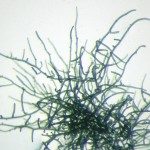Link to Pubmed [PMID] – 20333361
Anal Bioanal Chem 2010 Jul;397(5):1723-32
Harmful phytoplankton species are a growing problem in freshwater and marine ecosystems, because of their ability to synthesize toxins that threaten both animal and human health. The monitoring of these microorganisms has so far been based on conventional methods, mainly involving the microscopic counting and identification of cells, and using analytical and bioanalytical methods to identify and quantify the toxins. However, the increasing number of microbial sequences in the GeneBank database and the development of new tools in the last 15 years nowadays enables the use of molecular methods for detection and quantification of harmful phytoplankton species and their toxins. These methods provide species-level identification of the microorganisms of interest, and their early detection in the environment by PCR techniques. Moreover, real time PCR can be used to quantify the cells of interest, and in some cases to evaluate the proportion of toxin-producing and non-toxin-producing genotypes in a population. Recently, microarray technologies have also been used to achieve simultaneous detection and semi-quantification of harmful species in environmental samples. These methods look very promising, but so far their use remains limited to research. The need for validation for routine use and the cost of these methods still hamper their use in monitoring programs.


